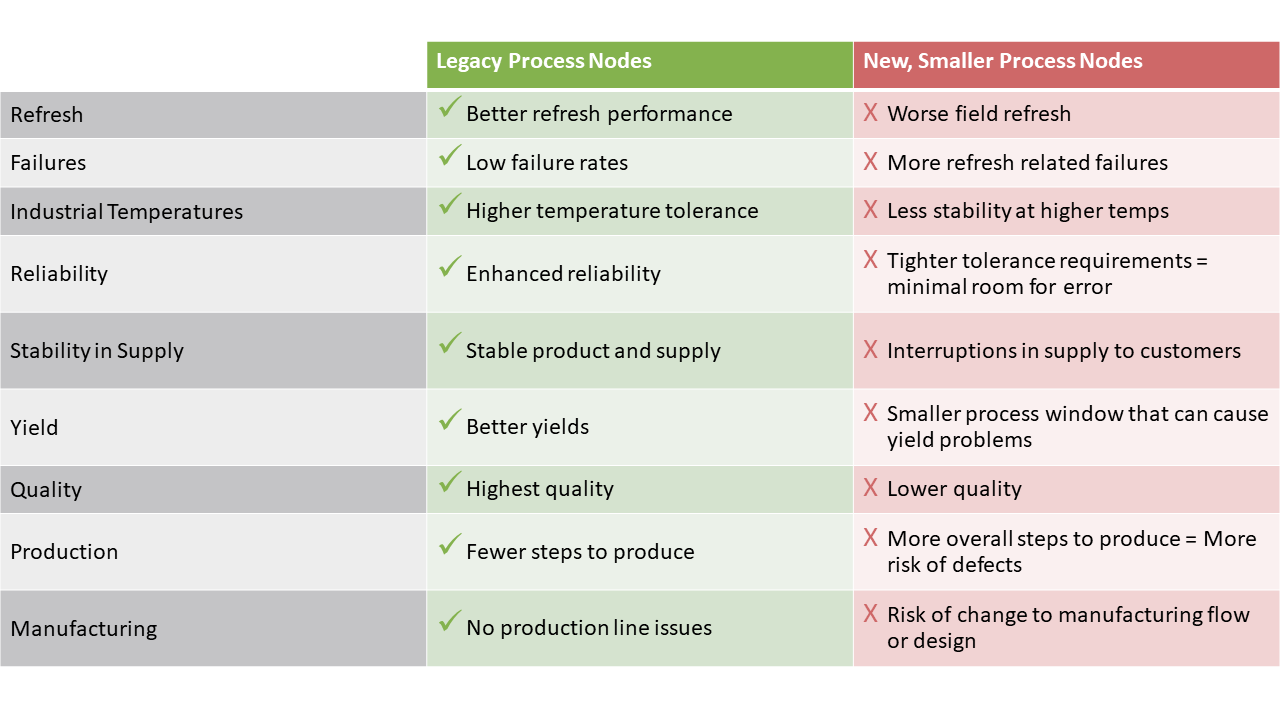INSIGNIS Technology Corporation
The Advantages of Legacy Process Nodes

With the continued growth of industrial and automotive memory segments, the need to provide customers with a stable supply of components on legacy process nodes has changed the support model for many memory suppliers. Instead of constantly pushing customers to smaller process nodes, some suppliers are actively working to stay on older technology in order to provide the benefits that legacy nodes offer to their customer base. Products that are produced on legacy process technologies consistently give better yields, better reliability results, and better refresh performance. These legacy products also have fewer fabrication-related issues because they are less complex and require a fewer number of steps to produce. These benefits combine to provide the ideal solution for customers looking for high quality and stable memory support.
When manufacturing semiconductor memory, yield and reliability are directly related to each other and are impacted by the size of the wafer’s geometry. Defect density curves are a well-established metric for semiconductor fabs. High yielding wafers provide better quality performance in the field. For any given facility, a shrink to the new process node will result in lower yields and worse quality metrics. The legacy process technology has larger spaces between critical nodes on the memory device, which translates into better yields and quality. With quality and reliability being key metrics for customers in the automotive and industrial segments, support from legacy process nodes is a clear advantage.
Refresh is a common fail mode on DRAM components for all customers. The challenge for the suppliers as they shrink to the new, smaller process node is that it’s very difficult to reach their cell capacitance targets and to improve the junction leakage in the array to be close to and comparable to the previous nodes. Unfortunately, the new process nodes are typically ramped into production without meeting the cell capacitance and junction requirements. This translates into worse field refresh and, therefore, results in more refresh related fails for the end customers. Additionally, the system refresh rate needs to double for every ~10°C increase in temperature, so as the temperature goes up, the refresh issue is exacerbated, and failure rates climb even higher.
Legacy process nodes have none of those disadvantages, and they give customers more maneuverability and reliability at elevated temperatures. The older process nodes are frequently able to take advantage of technology gains that were made during the development of newer nodes. When those advances can be safely and easily incorporated into the older nodes, the performance related to the refresh of those parts is improved, and failures decrease substantially. Since the temperature specification for industrial and automotive parts is much higher than the comparable commercial grade, the quality expectations are also much higher. Failures due to high refresh rates are simply not an option. It is clear that legacy process nodes provide the best solution for these markets.
Stability within the entire production line is another key benefit provided by staying on an older process node. The newer process nodes have more overall steps, which introduces more risk of defects and other fail modes. The tolerance requirements from step to step for the newer process nodes are also much tighter, which gives a smaller process window in which the fabs and tools must operate. These tight process windows frequently shift unexpectedly, causing yield problems and worsening quality. In extreme cases the suppliers are forced to scrap or downgrade a large portion of their line, which interrupts the supply of memory to their customers. Changes to the manufacturing flow or design are an additional risk on new process nodes. All new designs on the new process node go through lengthy debugging cycles. It is common for design changes to be made on a new process node more than a year after it has ramped into full production. These changes put the entire customer base at risk, as it is impossible to verify that all qualified customers will have no issues with the changes that are being made. Product support on legacy process nodes allows customers to avoid these production line issues.
Given the many benefits of running legacy process nodes, including better refresh performance, better yields with low failure rates, higher temperature tolerance, and enhanced reliability for automotive and industrial memory customers, it is not surprising that the memory suppliers who are committed to providing the highest quality and most stable product are choosing to remain on the older node and not go to the smaller one even when it is available.